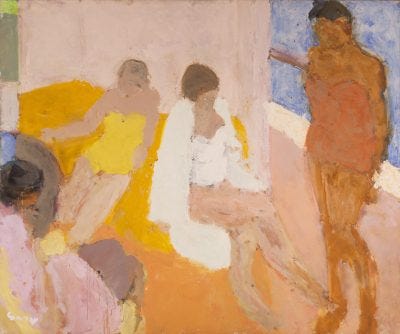One morning in 2005 the painter Sargy Mann woke up to total darkness. He’d had trouble with his eyes for years and now the inevitable had happened – he was blind.
Now without sight, Mann learned to move about his house through his memory of the space and his understanding of its dimensions. Soon he realized he could do the same to navigate a canvas. With this realization and with a measuring stick to mark out his work, he continued painting.
“Pottering about in the now-permanent darkness of his studio, he remembered the presence of a stretched canvas. Might as well give it a shot. His palette was always laid out in the same configuration. He rarely mixed colors in advance, but scumbled, glazed or layered directly on the canvas. To his surprise, it wasn’t as hard as he’d expected. He could play blindfold chess and this was not a dissimilar process. What mattered was constructing and adjusting the image in his mind, measuring and re-measuring with his stick, making a kind of haptic map or under-drawing with lumps of Blu-Tack before laying on the zones of colour. ‘It was difficult all right,’ he said, ‘but it had always been difficult.’” 1
Emphasis added because I could not love this more. Painting had always been difficult. He just happened to be blind now. Never mind, back to work.

“Doing it in the dark was a challenge, but not – measuring stick in hand – an impossibility.” 1
Years earlier when his sight was fading, Mann “took a hair dryer to the National Gallery, plugged it in and calmly dried his soggy, waterlogged eye in order to see the paintings. There was always a way of adjusting, capitalising on as well as compensating for the shift.”
Capitalizing and compensating. There was always a way for both.
When I’m thrown a curve ball the options I consider are quit or compensate. I never consider “Capitalize.” I never go so far as to bring a metaphorical hair dryer to the National Gallery and that’s why I love Mann’s example. It shows what’s possible when we consider capitalizing.
In total darkness, Mann found a new freedom. He painted his wife sitting in a chair, mapping out the scene entirely by touch:
“‘You silly bugger,’ he said to himself when he got up to cover the ugly brown chair with a white dust sheet, ‘you won’t be able to see it. You can make the chair any colour you like.’ If he couldn’t see colour, he was no longer under an obligation to record it accurately, but could instead assemble colour chords that were purely decorative. At last, his paintings could be as saturated as he liked.” 1
Reality was no longer a constraint. He couldn’t see it and there was no need to be true to its color. Now he was free to compose the scene in whatever colors he liked and he capitalized on the opportunity.
When we create in Real Life, we are always compensating. We’re making do with less time, sleep, attention, or energy than we’d like.
I think of this often as I care for my 18-month-old son. Reading The Little Blue Truck for the fifth time in a row, my mind sometimes wanders to what I might be doing instead – writing, running, finalizing that partnership deal, growing my company, putting dishes in the dishwasher. It’s hard not to wonder about how I would spend my time if I weren’t tending to a toddler.
I’m reminded of this question Cheryl Strayed asks, “What didn’t I write because I was catching my children at the bottoms of slides and spotting them as they balanced along the tops of low brick walls and pushing them endlessly in swings? What did I write because I did?”
I first read the story of Mann’s late paintings several years ago, before I had a child. I recently came back to it after having had a child, and I understood something new. The challenges we face in the various seasons of life force us to compensate. They are hard, painful, and denying this only makes it worse. But these scenarios also offer us raw material on which to capitalize.
We capitalize and we compensate.
There are things we won’t get to create because life presents us with certain constraints that make it impossible. And there are things we may only create because life presents us with these very same constraints. Both things are true.
This is different from bright siding things or turning lemons into lemonade or looking for a silver lining when there isn’t one. This is about acknowledging that there’s more than one narrative at play, more than one way to understand our circumstances and what’s possible as a result of the unexpected, the unwanted, the challenging, and the mundane. That is, what’s possible as a result of Real Life.
PS: Shout out to Christian who was in the Brainstorm Road Create Now session where I finally dug out the (fabulous) book where I first read the Mann story. I’d been thinking about writing this for ages, but hadn’t actually taken the time to go and find the book so that I make it happen. A smidge of accountability was just what I needed to get this essay started. If you’re also in need of a bit of accountability, we’ve got good news. We’re taking a limited number of new members this summer. Click here to sign up for our waitlist.




